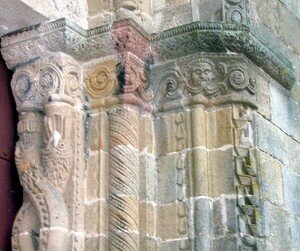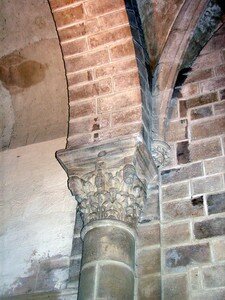Saint-Gervais-and-Saint-Protais church in Le Montet
 The
parish of Montet belonged formerly to the diocese of Bourges. This
Romance church marks the center of an old priory Benedictine founded in
1195 by the lord of Bourbon, Archambault II, and depended on the
monastery of Michel-of-The-Cluse with Avagliana close to Turin in
Piedmont.
The
parish of Montet belonged formerly to the diocese of Bourges. This
Romance church marks the center of an old priory Benedictine founded in
1195 by the lord of Bourbon, Archambault II, and depended on the
monastery of Michel-of-The-Cluse with Avagliana close to Turin in
Piedmont.
The top of the hill where it rises delivered the traces of an important ancient occupation, Neolithic site and old Roman camp.
Devastated by the Protestants in 1568, the original church, where the first Bourbon had chosen to raise their tombs, was cut down at the XIXème century by its part is.

 Currently, it comprises nothing any more but one nave and two sides finished by a small chorus.
Currently, it comprises nothing any more but one nave and two sides finished by a small chorus.
 Its capitals and its principal gate in the west received a carved decoration of a great interest.
Its capitals and its principal gate in the west received a carved decoration of a great interest.
 One
finds there, engraved in the stone, the indications on all energies
present in this place: the interlaced snakes show well both vouivres
crossing under the church. There would be also presence of artificial
underground rivers in the form of rollers.
One
finds there, engraved in the stone, the indications on all energies
present in this place: the interlaced snakes show well both vouivres
crossing under the church. There would be also presence of artificial
underground rivers in the form of rollers.
On the square, a magic square, and with the site of the Michel Saint, a cosmo-telluric chimney.
 On
the capitals, faced birds drinking with the same chalice, of the
interlacings, rinceaux and other sheets of acanthus recall those of
Souvigny, whereas the gate, whose Greek plank and the snakes are
authentically Romance, points out one of the gates of the monastery of
Cluse. The style of the capitals carries to believe that the team from
Burgundy about 1150 to embellish the close monasteries doubled of a
team of sculptors of the school of Auvergne for the capitals with
characters and the heads phytomorphes (spouting out of foliages).
On
the capitals, faced birds drinking with the same chalice, of the
interlacings, rinceaux and other sheets of acanthus recall those of
Souvigny, whereas the gate, whose Greek plank and the snakes are
authentically Romance, points out one of the gates of the monastery of
Cluse. The style of the capitals carries to believe that the team from
Burgundy about 1150 to embellish the close monasteries doubled of a
team of sculptors of the school of Auvergne for the capitals with
characters and the heads phytomorphes (spouting out of foliages).
 A superb triton still speaks to us about the two subsoil water currents with its fish bifide tail.
A superb triton still speaks to us about the two subsoil water currents with its fish bifide tail.
 On
another pillar, mouth of a bull (tellurism) leave the two currents,
which separate into two each one, then in three. What gives us 12 at
the end. Between these interlacings, a grenade, symbol of knowledge.
On
another pillar, mouth of a bull (tellurism) leave the two currents,
which separate into two each one, then in three. What gives us 12 at
the end. Between these interlacings, a grenade, symbol of knowledge.
 A
lion with head of man, wings of eagle and feet of bull (tétramorphe or
sphinx), the two legs back in a vase surrounded of the terrestrial
snake, energies of in bottom, (on the snake, the 7 will chakras
principal) shows the cord around the kidneys of the character on his
left (moreover it is not a node which closes the cord, but the two
sides pass one in another, “flow” is not cut). This character is well
anchored by the position of his legs to the ground, and connects
himself to the sky with a raised arm. Other hand, it shows its will
chakra coronal. The cord, or girdles monks marks the difference between
will chakras higher and lower. One of the feet of the character is
connected to a kind of bud-grenade, or perhaps the symbol of the
faults, on which the tétramorphe poses also a leg. The tail of the
animal ends in a head of… I do not know too what, (it could be that it
is the head of the bull considering previously) looking at behind,
towards the past, towards the experiment.
A
lion with head of man, wings of eagle and feet of bull (tétramorphe or
sphinx), the two legs back in a vase surrounded of the terrestrial
snake, energies of in bottom, (on the snake, the 7 will chakras
principal) shows the cord around the kidneys of the character on his
left (moreover it is not a node which closes the cord, but the two
sides pass one in another, “flow” is not cut). This character is well
anchored by the position of his legs to the ground, and connects
himself to the sky with a raised arm. Other hand, it shows its will
chakra coronal. The cord, or girdles monks marks the difference between
will chakras higher and lower. One of the feet of the character is
connected to a kind of bud-grenade, or perhaps the symbol of the
faults, on which the tétramorphe poses also a leg. The tail of the
animal ends in a head of… I do not know too what, (it could be that it
is the head of the bull considering previously) looking at behind,
towards the past, towards the experiment.
 It
with the opened mouth, to tell, prevent? The tétramorphe on other side
has a mane different. I will lean for a sun face and a moon face, which
connects to the stars.
It
with the opened mouth, to tell, prevent? The tétramorphe on other side
has a mane different. I will lean for a sun face and a moon face, which
connects to the stars.
Would the energy of the place enable us to raise us?
In
the “exoteric” explanation, it is known as that this capital represents
the Daniel prophet in the lion's den, raising a hand in order to impose
the respect on the animals…
That those which have ears hear.
And where knowledge will nest?
The bell-tower, located at the north-western angle of the monument, is the work of the Lassus architect, author of the Sacred Heart of Mills. It was useful of the stones of the old ruined church.
The length of the church is 60 meters, width 15 meters, length of the transept 28 meters, its width 6 meters, the height of the sides of 9 meters, the height of the transept of 13 meters and that of the great nave of 15 meters.
Inside, several models represent Montet at the various ages of its history:
 Inhabited
since highest antiquity, the hill was, before the hand of the man had
not flattened the slopes of them, a rock, at the top of which the
Gallic ones built a first sanctuary. The Romans also installed a
strengthened camp, with the presence of a temple.
Inhabited
since highest antiquity, the hill was, before the hand of the man had
not flattened the slopes of them, a rock, at the top of which the
Gallic ones built a first sanctuary. The Romans also installed a
strengthened camp, with the presence of a temple.
 Christianity
was established in the area, and Montet was évangélisé by Saint Ursin.
A modest church was built close to the pagan sanctuary. The village is
protected by palisades out of wooden against the invasions wisigothes.
Montet from its geographical position, was located at the junction of
old ways Roman, therefore Gallic, which has permi its rapid
development.
Christianity
was established in the area, and Montet was évangélisé by Saint Ursin.
A modest church was built close to the pagan sanctuary. The village is
protected by palisades out of wooden against the invasions wisigothes.
Montet from its geographical position, was located at the junction of
old ways Roman, therefore Gallic, which has permi its rapid
development.
 With
the Middle Ages, Montet became an observation post. The monastery was
founded into 940 and became an important priory of more than 50 monks.
It is on their initiative that the wall of enclosure of the city was
set up. The church prieurale was regarded at the time as most beautiful
and vastest of the religious buildings of Bourbonnais. Until the
disaster of 1568, where the city was devastated by the Protestants.
There remain traces of the fire in the church, on the stones.
With
the Middle Ages, Montet became an observation post. The monastery was
founded into 940 and became an important priory of more than 50 monks.
It is on their initiative that the wall of enclosure of the city was
set up. The church prieurale was regarded at the time as most beautiful
and vastest of the religious buildings of Bourbonnais. Until the
disaster of 1568, where the city was devastated by the Protestants.
There remain traces of the fire in the church, on the stones.

/https%3A%2F%2Fprofilepics.canalblog.com%2Fprofilepics%2F1%2F1%2F116167.jpg)
/https%3A%2F%2Fstorage.canalblog.com%2F49%2F16%2F312499%2F14620054_o.jpg)
/https%3A%2F%2Fstorage.canalblog.com%2F53%2F18%2F312499%2F14151229_o.jpg)
/https%3A%2F%2Fstorage.canalblog.com%2F07%2F05%2F312499%2F14149867_o.jpg)
/https%3A%2F%2Fstorage.canalblog.com%2F11%2F35%2F312499%2F14149307_o.jpg)
/https%3A%2F%2Fstorage.canalblog.com%2F90%2F14%2F312499%2F14125247_o.jpg)










/https%3A%2F%2Fstorage.canalblog.com%2F12%2F98%2F137895%2F6624411_p.jpg)
/https%3A%2F%2Fstorage.canalblog.com%2F34%2F82%2F137895%2F27207854_p.jpg)
/https%3A%2F%2Fstorage.canalblog.com%2F32%2F37%2F137895%2F15872299_p.jpg)
/https%3A%2F%2Fstorage.canalblog.com%2F37%2F81%2F137895%2F15879822_p.jpg)